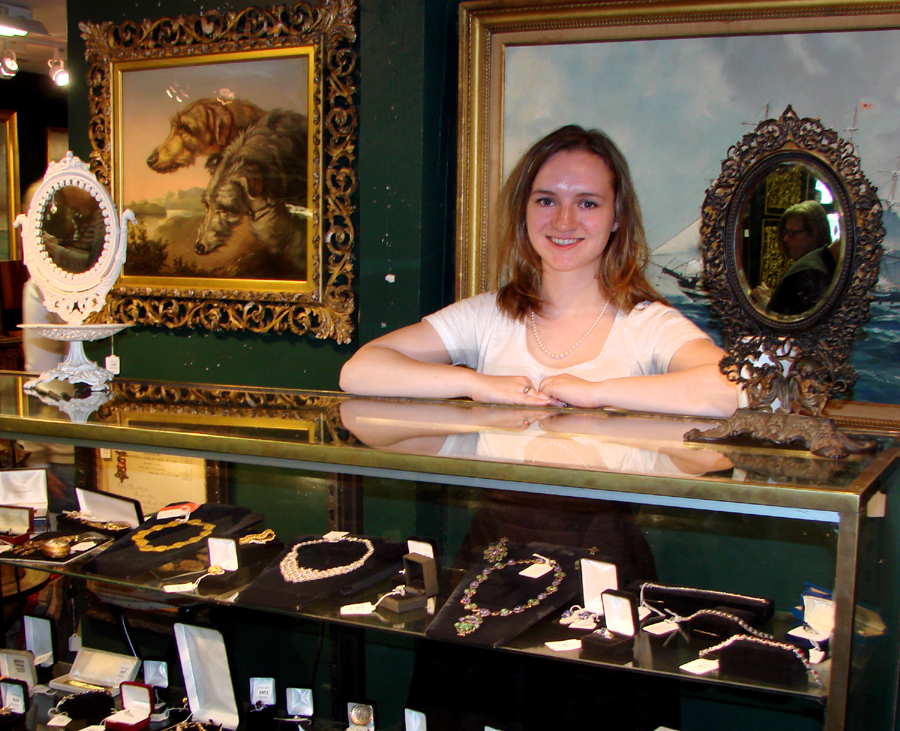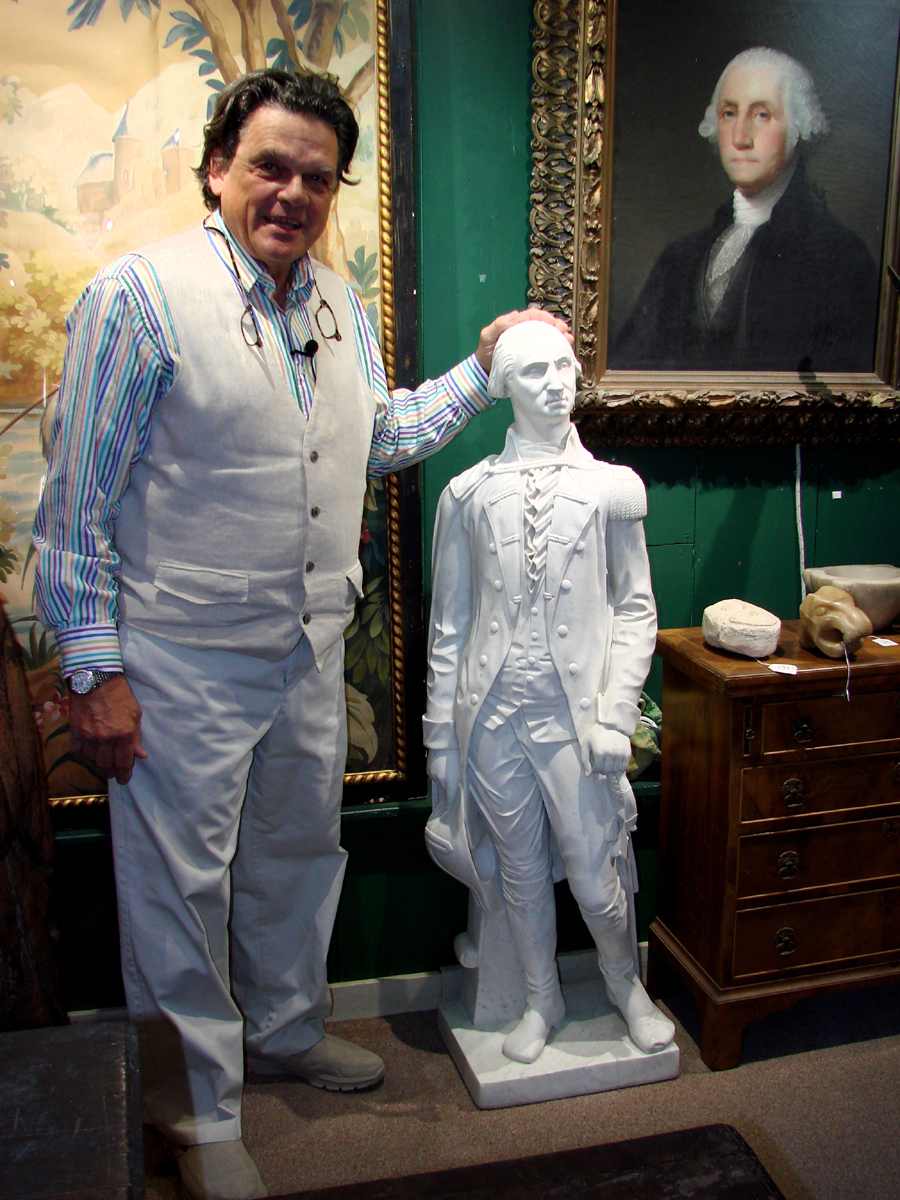
Kaja Veilleux stands here with a 53¼-inch white marble statue of George Washington, unsigned, Nineteenth Century, that passed. A marble bust of Washington, possibly after a work by Horatio Greenough,did sell here for $8,775.
Review By Rick Russack; Photos Courtesy Thomaston Place Auction Galleries
THOMASTON, MAINE — Kaja Veilleux, owner of the Thomaston Place Auction Galleries, was pleasantly surprised when a gold and emerald lady’s ring dating to First Century BCE finished at $152,100. The ring, along with a necklace made from Byzantine gold coins, came from the estate of a woman who summered in Maine. The two-day auction, May 21–22, had more than 1,300 lots, as do most sales here.
The Greek ring came from the estate of Anne Bigelow Stern, whose summer home was in Blue Hill. The ring is believed to have been part of a gold hoard with links to the Byzantine empire and was discovered in 1909 in Egypt. Known as the Asyut treasure, it was reportedly taken to Egypt in the Seventh Century for safekeeping. This ring, of 22K or 24K yellow gold and having a large emerald, was missing five of its smaller stones. Near duplicates of this ring are in the Staatliche Antikensammlungen in Munich and the Rhode Island School of Design. The high estimate was $30,000, but with ten phone bidders in competition, bidding quickly hit $152,000.
A necklace made of 12 Byzantine gold coins from the same estate reached $14,040. The auction catalog has an informative essay about Stern and she is shown wearing the necklace in a photograph. A family representative told the auction house after the sale that “she wore the necklace nearly every day.”
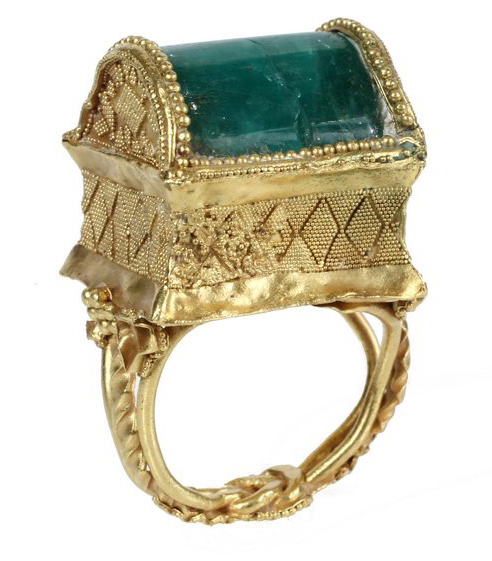
The highest price of the sale was achieved by this gold and emerald ring dating back to the First Century BCE. It may have been part of the Asyut hoard, discovered in Egypt in 1909, perhaps having been brought to Egypt in the mid-Seventh Century for “safekeeping.” Ten phone lines competed and the ring quickly reached $152,100, more than five times its estimate.
The variety of goods on offer was wide and one may be surprised at what turns up. You might not expect to be able to bid on a modern 36-foot cabin cruiser or a Bentley sedan or a Mercedes convertible, but all turned up in this sale. Buyers could also choose from porcelain, silver, ancient artifacts, folk art, estate jewelry, Native American material, Asian antiques, Continental and American furniture, rugs, nautical antiques, art glass, music boxes and more. There were about 100 bidders in the room, several phone lines were available, absentee bids were executed and online bidding was available on three platforms. The sale totaled $1,433,250.
The second highest price of the sale was achieved by a Qing dynasty squat, cauldron-form open censer with two handles, three nub feet and a Kangxi seal mark (1662–1722). It went 50 times over estimate to fetch $70,200. After the sale, John Bottero, Thomaston Place vice president, told Antiques and The Arts Weekly, “We expected it would do well. There were several requests for additional photos and condition reports. The people who know that material seem comfortable bidding for an object that they haven’t handled.”
Other Chinese bronzes also exceeded estimates. A round lidded bronze box, Qing period, with a Buddhist inscription on the lid realized $4,387. Several items from a single-owner collection of Asian bronzes also did well. A 6-inch Chinese bronze sculpture of a seated scholar brought $14,040, while a Hindu bronze bell with raised details from Bali earned $4,914.
Folk art included two carousel figures, a pair of carnival carvings, weathervanes and more. A well carved, circa 1905, running cat carousel figure, 48 inches long, possibly retaining its first coat of paint, sold for $9,945, and an outside row horse, attributed to Armitage-Herschell in later black paint, reached $4,095. A pair of 39-inch oak carvings that might have come off a carousel or a carnival wagon realized $5,031. Each carving depicted a partially nude, red haired woman, holding an arm over her head (probably for a flag). One of the bargains of the day was a matching pair of hooked rugs with hexagonal panels illustrating dogs, ducks, a house, flowers, an airplane and more, which brought only $292.
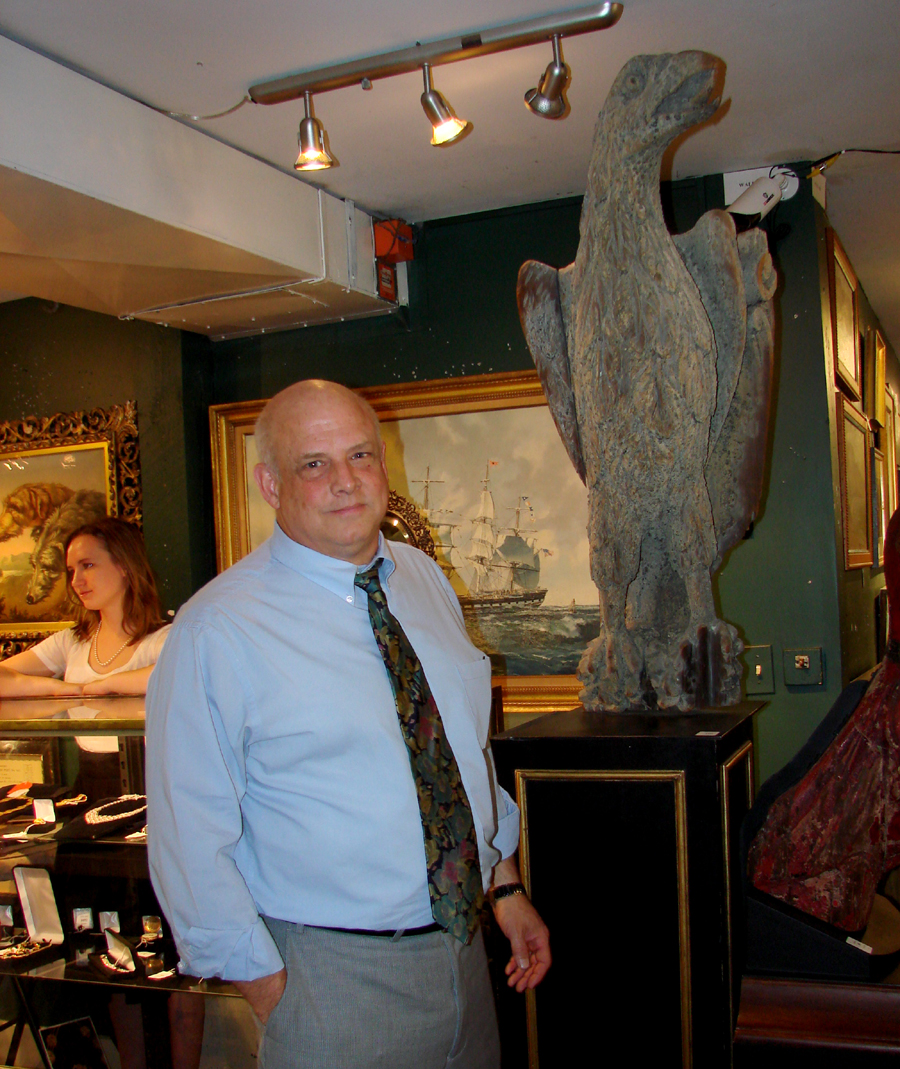
John Bottero, vice president of Thomaston Place Auction Gallery, handled some of the selling and phone bids.
Military items, early maps and historical ephemera often exceeded estimates. A rare 1775 Revolutionary War broadside commemorating the Battle of Bunker Hill topped its $800 high estimate to finish at $17,550, despite some condition issues. It had been printed and sold by Nathaniel Coverly, Boston, and included a woodcut illustration. The American Antiquarian Society owns a large collection of Coverly’s broadsides.
A brightly colored Civil War marching snare drum, in fine original condition, with an eagle and shield on a blue field earned $7,605. A letter written by Colonel Elmer Ellsworth, the first Union officer killed in the Civil War, finished at $2,574 and a Brady carte de visite of Ellsworth brought $702. Ellsworth was a close friend of President Lincoln, having worked in his Springfield law office.
A hand-stitched 12-star Union field flag reached $9,945, also well over estimate. Abraham Ortelius’s first map of the Pacific, published in Antwerp about 1590, went to an absentee bidder for $3,510. The first detailed map of the Mississippi River, depicting the Gulf region, Texas and New Orleans, published in Paris in 1718, achieved $1,989.
Multiple bidders competed for sets of porcelain and silver flatware. A 256-piece Herend dinner service in the Rothschild Bird pattern fetched $12,870. Nine matching table pieces brought $1,287. Georg Jensen silver did well. A set of 177 pieces of flatware in the Acorn pattern, weighing more than 192 troy ounces, reached $12,870, while 21 matching serving pieces went out at $3,510. Another lot of four matching tableware pieces sold for $1,989.
Justin Cobb, an Amherst, Mass., dealer in nautical antiques, made several purchases and was quite pleased with the sale. He bought an incredibly detailed bone and baleen prisoner of war model of a circa 1805 British man-of-war. It was mounted in a straw marquetry decorated case, behind glass, with angled mirrors so that all sides would be visible. It had been passed in a previous auction, but this time it sold for $9,360.
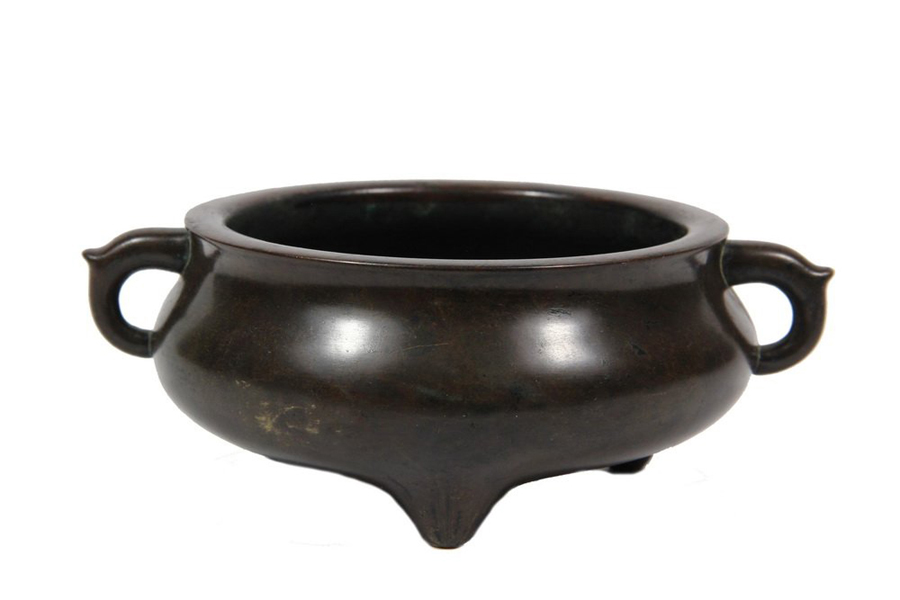
Bringing the second highest price of the day, $70,200, was this small Chinese bronze censer with a Kangxi seal mark (1662–1722). It was 4¾ inches wide.
Cobb also bought a rare pocket compass/timepiece made by Lorenz Grassel, Augsburg, circa 1770. The estimate was $600/800 and before the sale Cobb commented that it was worth much more. Cobb paid $555 for it — specialized knowledge pays off. Other marine items included a breech loading whaling gun in its original case made by Cunningham & Cogan, patented 1876, which realized $3,861. It had belonged to a retired Civil War General Davis Tillson, and had been used on the 50-foot steamer Hurricane, which he owned. A detailed portrait of the schooner J.W. Seaver under full sail, painted by Joseph B. Smith (American, 1798–1876), realized $17,550. Smith was active in New York and worked with his son, William. The catalog notes that paintings signed or labeled by Joseph Smith “are very rare.”
The sale included several firearms. An untouched American Revolutionary War era, 42-inch “Brown Bess” musket, marked “Dublin Castle” and “GR” with crown on the lockplate, fetched $2,574. It was sold with an Eighteenth Century shot flask from cow horn. An 1894 model, .30-caliber Winchester saddle ring carbine in fine condition, with more than 90 percent of the original bluing, went for $2,223 and a Colt .45-caliber single-action six-shooter revolver reached $1,287. A bronze working model of an Eighteenth Century French and Indian War-era siege mortar, mounted on a walnut carriage with skids and in very good condition, brought $2,106.
While the sale included numerous other interesting items, there is one more that must be mentioned. A collection of 31 books on Sherlock Holmes, several signed by their authors, sold for $117, less than $4 per book.
After the sale, Bottero told Antiques and The Arts Weekly that they felt the sale went well. “There were some pleasant surprises, like the ring and some of the silver. The Daum Nancy tall vase did well [$14,040] and we were glad to get a good price for the cabin cruiser, since the money goes to a worthwhile charity.”
All prices reported include the buyer’s premium.
For additional information, www.thomastonauction.com or 207-354-8141.

